The best plug-in smart outlet
Start your search with Wemo.

By Rachel Cericola
This post was done in partnership with Wirecutter. When readers choose to buy Wirecutter's independently chosen editorial picks, Wirecutter and Engadget may earn affiliate commission. Read the full plug-in smart outlet guide here.
After spending more than two years testing 41 smart outlets, we're confident that the Wemo Mini is the best smart outlet plug-in adapter for people who want to add remote control and automation to their existing lamps, fans, or other electrical devices. It's the most reliable Wi-Fi smart plug we tested, it's simple to use, and it works with Amazon Alexa, Apple HomeKit, and Google Assistant.
The Wemo Mini is the only model that has been rock-solid reliable over long-term use, offers a compact design that won't block both outlets on a wall plate, and supports all the major voice-control platforms. Like most of the smart plug-in switches we tested, the Wemo Mini is easy to set up: Just plug it into an outlet, download an app to your phone, set up the wireless connection, and then control lamps, small appliances, and even higher-draw devices like fans and air conditioners. The Wemo family also includes light switches and dimmers, so it's easy to expand your system.
The Lutron Caséta Smart Lighting Lamp Dimmer costs quite a bit more than the Wemo Mini, but it has two outlets, allowing you to control two lamps or strings of lights at once (though not independently). And it lets you dim those lamps rather than just turning them on and off—a rarity among smart plugs. The Caséta system connects over a robust wireless mesh network, rather than Wi-Fi, so Wi-Fi dead spots in your house aren't a problem, but it requires Lutron's proprietary Caséta Smart Bridge hub. We recommend you buy a kit that includes the hub. This outlet supports only lamps, not fans or other motors, but the Caséta line includes compatible in-wall dimmers, window shades, and remotes, so this model is ideal for people who want a larger smart-home system. It works with Amazon Alexa, Apple HomeKit, Google Assistant, Nest, Samsung SmartThings, Wink, and more.
If you want to be able to control outdoor devices—during the holidays or all year long—the iClever IC-BS06 smart plug can weather the outdoors better than you can, operating in temperatures ranging from –4 to 140 degrees Fahrenheit. It has two plugs that you can control remotely and independently using the app or voice control (via Amazon Alexa and Google Assistant, but not Siri), and you can configure automations based on time, weather, humidity, temperature, air quality, sunrise and sunset, or triggers from other iClever devices.
Why you should trust us
I have written about consumer electronics for more than 15 years and have tested a slew of smart-home devices, from remotes and security cameras to AV receivers and speakers. As a former editor for Electronic House and Big Picture Big Sound, I have written buying guides for multiple consumer-electronics products, in addition to tech articles for Wired, Woman's Day, GeekMom, Men's Health, USA Today, and others.
Who this is for
A smart plug-in outlet is a perfect starter device for someone interested in smart-home technology: This small device plugs into any standard household electrical outlet, letting you use a phone or tablet to control whatever you've plugged into the smart outlet, as well as to set up schedules and integrate the device into larger smart-home activities. You don't need fancy hubs, programming skills, or an installer on speed dial to use smart outlets, and they're immediately useful with very little fuss.
If you have a smartphone and an empty outlet in your house, you can automate something easily. Putting even just one smart switch into your home can ensure that you'll never enter a dark house; add a few and you can control items such as household fans, speakers, slow cookers, and air conditioners.
Some smart outlets (including three of our picks) communicate via Wi-Fi, while others use Bluetooth. All the Wi-Fi–enabled smart plugs we found operate on the 2.4 GHz frequency range. Although 5 GHz Wi-Fi is faster, these devices don't benefit from the extra speed of 5 GHz, and 2.4 GHz offers longer range. (All modern Wi-Fi routers support both 2.4 GHz and 5 GHz.)
How we picked
We searched the Web and online stores for smart plugs, looking for reviews and roundups. We came up with a list of models that we then narrowed down based on the most important features you should expect from such a device:
Scheduling: All smart outlets allow you to schedule devices to go on and off at specific times of the day or week. We gave bonus points to outlets that offered additional customization, including individual days and triggers such as sunrise or sunset, temperature, and more.
Smart-home integration: Every smart plug offers some level of smart-home support. The bare minimum should be voice-control integration through Amazon Alexa, Apple HomeKit (Siri), or Google Assistant. Even better is compatibility with whole-house systems through Samsung SmartThings, Wink, Works with Nest, and IFTTT (If This Then That).
Wireless technology: Wi-Fi–enabled smart outlets are typically the easier and more affordable option, as they don't need other devices to function, and you can find models for indoors and outdoors. Bluetooth smart outlets, in contrast, require you to be within Bluetooth range to control them, unless they support Apple HomeKit, in which case you can control them when you're away from the house if you have a HomeKit gateway (an Apple TV, a HomePod, or a stay-at-home iPad).
To hub or not to hub: Smart plugs should be easy—you usually don't need a separate box (a hub or gateway) if you just want to turn a light on and off. But a hub-based system may offer features (such as HomeKit compatibility) or functions that make it a worthwhile exception.
Additional features: Some smart plugs have other interesting features, such as energy monitoring, which can be a nice perk if you're wondering how much juice your air conditioner, fan, or table lamp is consuming.
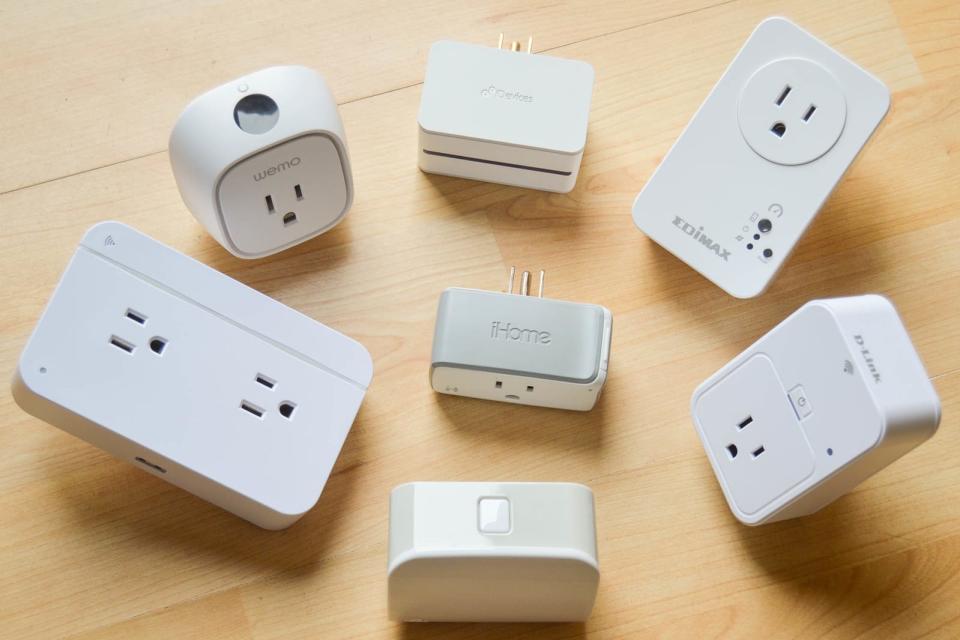
The average price for a smart outlet is about $30—you shouldn't need to pay more than that unless a particular outlet offers a certain advantage you want, such as an extra outlet or compatibility with a specific system.
How we tested
For each smart outlet in our test group, I downloaded the appropriate app to an iPhone 7, an iPad, and a Samsung Galaxy S6. Most of the switches connected to Wi-Fi easily and were simple to operate. I kept all of the plugs confined to the lower level of my 1,250-square-foot house but operated them from across the house, out in the driveway, and across the street (up to 150 feet away). For smart switches that offer control from afar, I played around with the settings while at the grocery store (2 miles away), the gym (10 miles away), and other houses (up to 50 miles away). To keep things interesting, I plugged a variety of items into each test switch, including (at different times) two table lamps, two fans, a white-noise machine, a radio, and even a flat iron. All of the plugs operated well, except where noted in the Competition.
When possible, I paired switches to an Amazon Echo Dot, an Echo Plus, an Apple TV, Nest devices, IFTTT, and each other.
Our pick: Wemo Mini
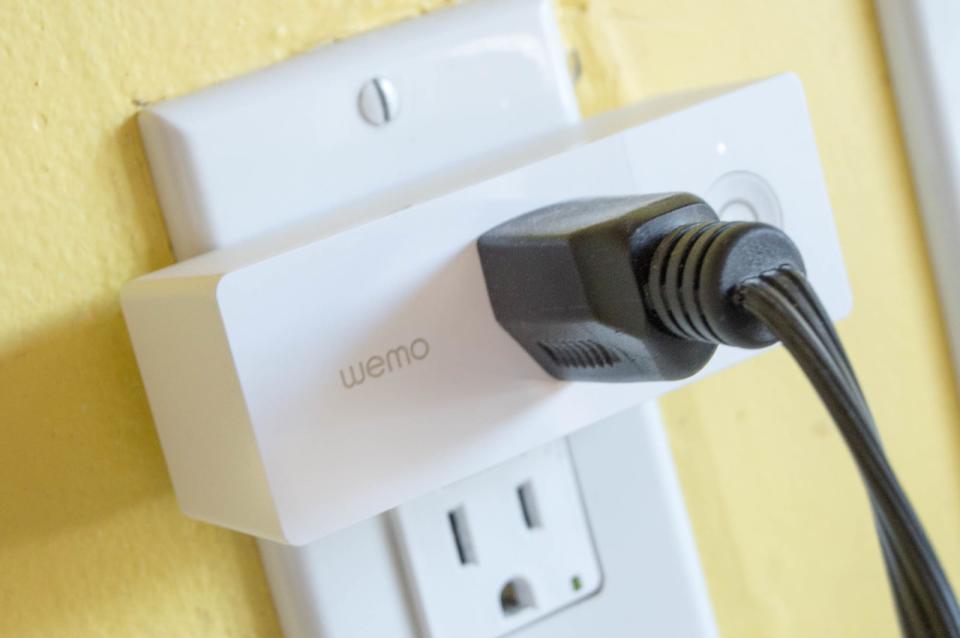
After more than 18 months, we've found the Wemo Mini to be consistently reliable, unobtrusive in a wall socket, and an affordable way to get started with smart-home devices. It's the best-performing Wi-Fi smart plug that's compatible with all three major voice-control platforms: Amazon Alexa, Apple HomeKit, and Google Assistant. The Wemo iOS and Android apps provide remote control, scheduling, and grouping for an infinite number of Wemo devices, including the Wemo Mini, the Wemo Insight, and Wemo in-wall light switches.
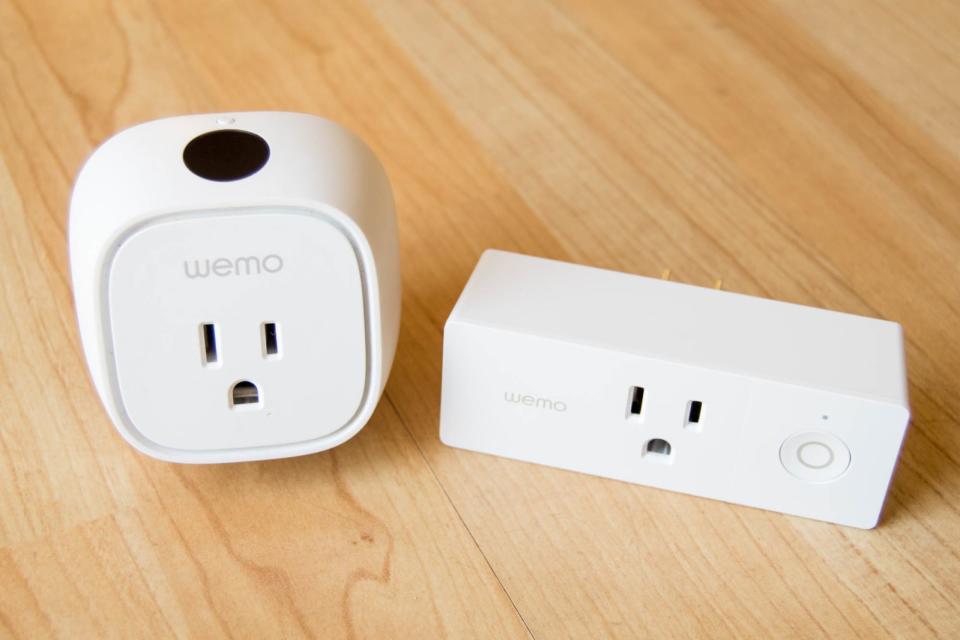
The Wemo Mini is compact enough to fit into one socket in a duplex outlet without blocking the second one, and its wide, thin shape allows you to place it in either the top or bottom socket without blocking the use of other bulky plugs—some larger competitors fit in only one and block the other. You can even stack two Minis in the same duplex outlet.
The Wemo Mini can also operate higher-draw appliances with motors or heating elements—such as air conditioners and coffee makers—making it more versatile than some of the other smart outlets we tested. For people who don't want to deal with elaborate smart-home setups but still want to start cooling their apartment off before they get home, a Wemo can do the job whereas a Lutron smart plug can't.
The switch easily connects to Wi-Fi without needing a hub. It performed reliably throughout more than a year of testing, providing on/off control from inside and outside the house whenever called upon. (Other smart plugs would occasionally disconnect from my network or respond slowly to commands.) I even created repeatable schedules and rules, which consistently turned lamps and fans on and off automatically at set times of the day.
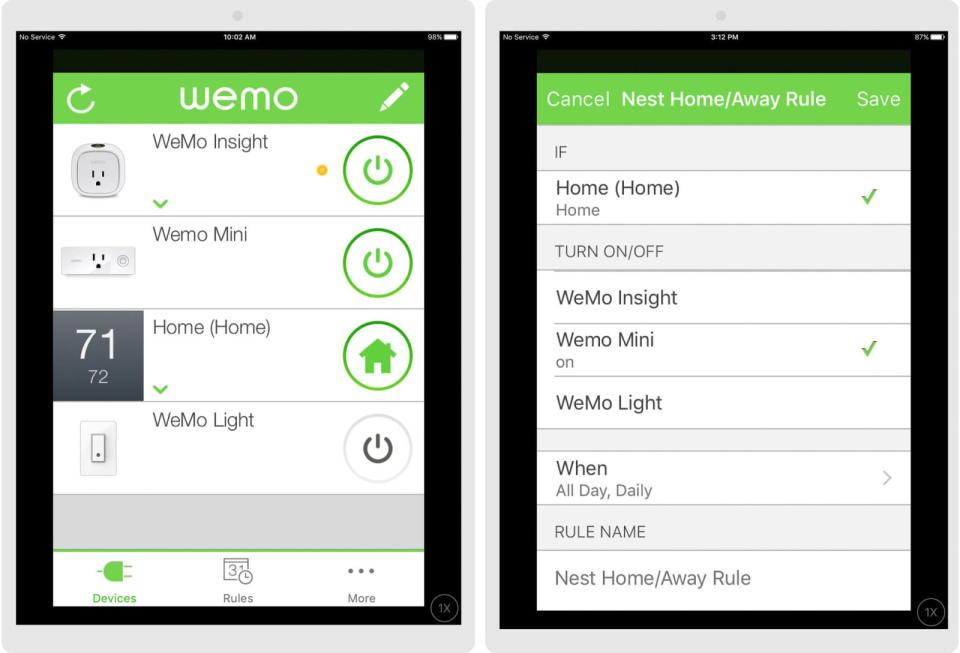
The Wemo Android and iOS apps are almost identical, offering on/off controls, rules, groups, and timers. Unlike many smart plugs, the Wemo Mini accepts settings to go on and off at certain times (versus separate rules for each), as well as to trigger based on local sunrise and sunset times. Both app versions can combine all Wemo devices and other compatible smart-home products on one screen, and each app makes everything easy to find and use. The apps even include a photo of each Wemo device or let you use your own photo for each (your lamp, your fan, and the like). The Mini is also one of the few models on our list with options for an away mode, which can randomly turn devices on and off during a predetermined time period.
One of the other ways the Wemo Mini stands out is in its wide compatibility with other smart-home devices. In addition to integrating with fellow Wemo devices, such as the Wemo Insight outlet and Wemo in-wall light switches, the Mini is the most reliable Wi-Fi plug we tested that works with Amazon Alexa, Apple HomeKit, Google Assistant, Nest, and IFTTT. The Mini used to require a bridge to make it compatible with HomeKit, but that necessity was eliminated with a firmware update, downloaded via the Wemo app. We found Alexa to be easy to use with the Mini; it linked quickly and responded consistently to on/off commands and automations. For example, we created an automation so that whenever we said "Alexa, dinnertime," the Mini would trigger a table lamp and the Lutron Caséta (our in-wall light switch pick) would flip an outside light off. We also grouped the Mini with a separate light so that we could control both by saying "Alexa, turn on the living room." (I also used the Mini with Siri/HomeKit, but that arrangement was a bit more buggy; based on my experiences with Apple's smart-home platform, I suspect this was more an issue with Siri/HomeKit than with the Wemo Mini.)
Flaws but not dealbreakers
The slightly larger Wemo Insight switch offers (via the Wemo app) features for monitoring energy use. We'd like to see those features for the Mini, but we can live without them.
Best for lamps and whole-home lighting: Lutron Caséta Smart Lighting Lamp Dimmer
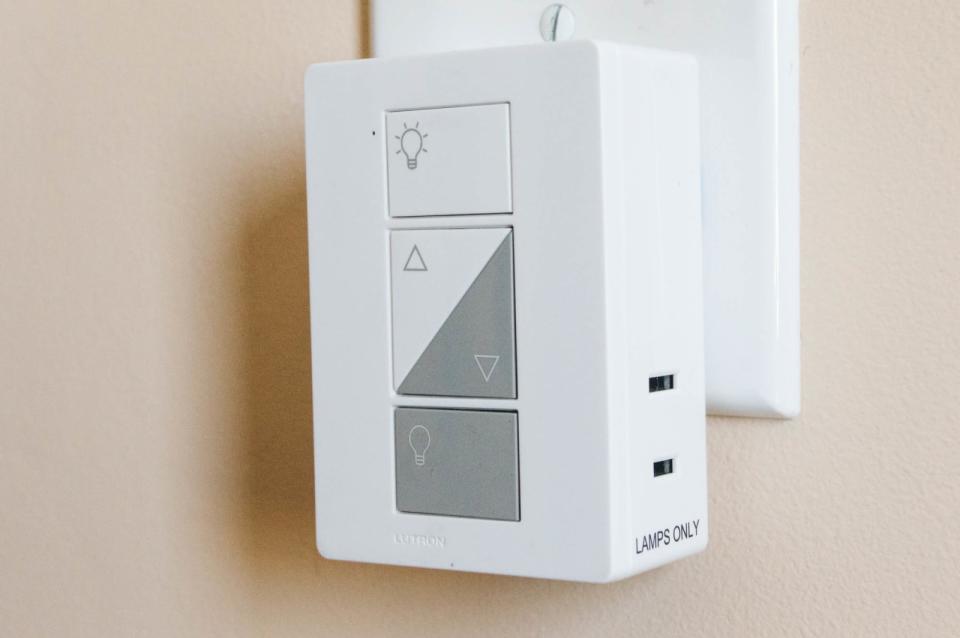
The Lutron Caséta Smart Lighting Lamp Dimmer is the only model we've found that includes two outlets and dimming capabilities. It's ideal if you're looking to go beyond a simple plug or two and want to add smart lighting throughout your house. However, it's also the only model on our list that requires a central hub, which adds to the cost of a system.
For the money, Lutron gives you a rock-solid system that ties your lights together and can link with other devices, such as thermostats, shades, and cameras. Lutron's Caséta system is compatible with more smart-home partners than any other plug on our list: It supports Amazon Alexa, Apple HomeKit, Google Assistant, Ecobee, IFTTT, Nest, Samsung SmartThings, Sonos, Wink, and much more. We easily tied the lamp dimmer in with Alexa and HomeKit so we could turn the outlet on and off, as well as set specific lighting levels, using voice commands. We also created a scene that would turn a HomeKit-enabled air conditioner to 67 degrees whenever the Lutron lamp dimmer was turned on.
Unlike the Wemo outlet, the Lutron model is designed specifically for dimmable lamps—a limitation emblazoned right above each outlet and confirmed to us by a Lutron representative. In other words, your fans, air conditioners, radios, and curling irons are not welcome here. This Lutron plug is not rated for motor inrush current (those few milliseconds of "whoosh" when you turn on an air conditioner, for instance), which could damage it. And frankly, it wouldn't fit some of those devices anyway, since both outlets are missing the ground prong. It's specifically rated for lamps, but if one of those isn't dimmable, the plug will just turn it on or off.
The dimmer itself is easy to use and offers dimming capabilities for two outlets, but you can't control the two outlets independently—they turn on and off together. This is okay if you're using the plug to control holiday lights that need to turn on at the same time, for example, but you can't set two connected lamps to different levels of brightness.
The Lutron smartphone app allows for different schedules every day of the week (or the same one every day), based on time or sunrise and sunset. You can also create scenes that can trigger multiple devices, as well as Smart Away, which can turn the plug-in dimmer on randomly between the hours of 6 p.m. and 11 p.m. to make it look like you're home when you're away.
As we mentioned above, to use this plug-in dimmer, you need the Lutron Caséta Smart Bridge, a hub that plugs into your router. This device adds to the overall cost, but you can purchase a starter kit that includes the Smart Bridge, two plug-in outlets, and a wireless remote to control the entire setup. (The plug-in dimmer and hub also work with our top in-wall light-dimmer pick.) Lutron says one Smart Bridge covers a 2,500-square-foot area, and the lamp dimmer acts as a range extender.
Although we didn't have connection issues with any of our picks, the Lutron system operates at a lower radio frequency than most smart-home devices. If you have a crowded wireless environment, the Lutron system may be susceptible to less interference.
For an outlet outside: iClever IC-BS06

If you're looking to extend your smart home to the outdoors, the iClever IC-BS06 smart plug is the way to go. This weatherproof device has the widest range of operating temperatures (–4 to 140 degrees Fahrenheit) of any outdoor smart outlet we tested. It has two outlets that you can control independently, and it's compatible with Amazon Alexa and Google Assistant (but not Apple's HomeKit or Siri). You can also control it manually or by voice within the outlet's own smartphone app, or set on/off triggers based on time, local weather, and more.
Although the device itself has only a simple toggle button that turns both outlets on or off together, within the app you can control each outlet independently and name them so you can use voice commands for each via Alexa or Google Assistant. For example, in our testing, we named them "fan" and "radio"; both responded correctly to Alexa voice commands. iClever also gives you in-app voice control, which is a nice touch, but you can use it only to turn the entire receptacle on and off.
The iClever IC-BS06 uses the Smart Life app, which has some similarities to the apps for Geeni, Monoprice, Top Greener, and Aukey. All of them also use the same Alexa/Google skill, and you can't mix manufacturers within one skill. In other words, you can't have an iClever outlet and an Aukey outlet and expect to use voice commands. Otherwise, the app is easy to use, allowing for scheduling as well as for scenes based on local weather, humidity, temperature, or air quality, plus sunrise and sunset, and the status of other iClever devices.
Also, we appreciate that this device works with IFTTT, but functionality is currently limited. Even so, between its dual independent outlets, features, performance, and price, the iClever IC-BS06 smart plug is still our top choice for outdoor use.
Budget pick: iClever IC-BS11
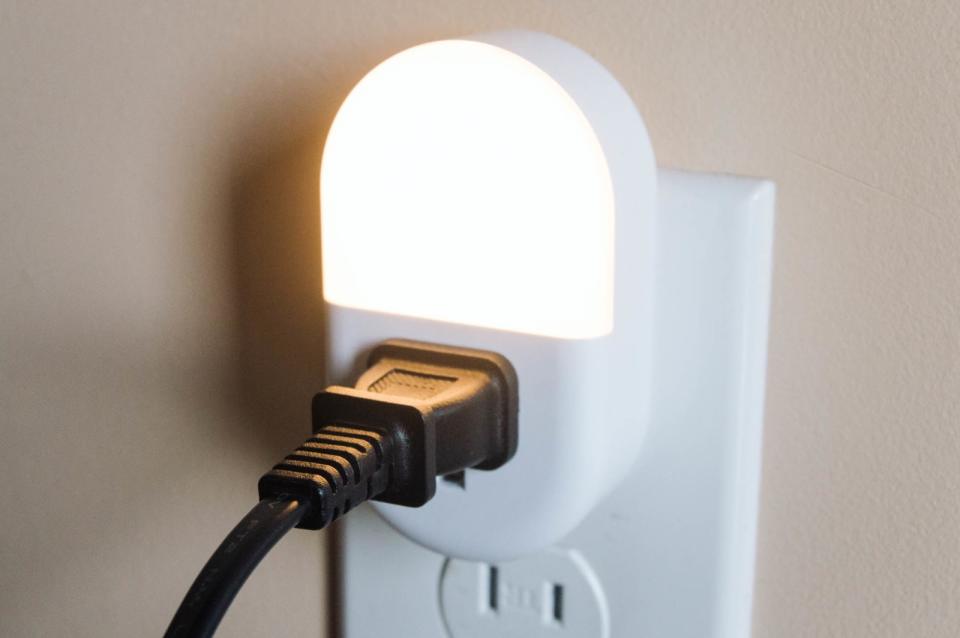
If you don't need HomeKit but do have a need for a lot of smart plugs, pick up the iClever IC-BS11. This reliable option includes support for Alexa, Google Assistant, and IFTTT, has an integrated night-light that you can dim and control separately from the outlet, and costs about half of what most smart plugs cost, which means you can add more remote control around the house on a budget.
If you're looking for bells and whistles like an away mode, energy monitoring, or additional smart-home integration, the iClever IC-BS11 doesn't have those extras. It uses the same Smart Life app as our outdoor pick, which means it functions the same and also uses the same Alexa/Google skill. It also has IFTTT support, although it's currently limited.
One of our favorite features on the iClever IC-BS11 is an integrated night-light. This can be controlled independently from the outlet, both through the app and by using Alexa and Google Assistant. For instance, we named it "hallway night-light," so we could call out and have it react accordingly. It can also be scheduled to light up dark rooms and hallways on a nightly or weekly basis. The night-light includes adjustable brightness, which can be controlled through the app or voice commands, or be scheduled to trigger based on time of day, sunrise and sunset, local weather, humidity, temperature, air quality, and the status of other iClever devices.
If you don't love the night-light, it can be turned off, or you can opt for the iClever IC-BS08. This unit functions exactly the same way, but with a more compact design. It's even sold in pairs for the same price. However, having a dimmable, integrated night-light was something we found useful—and that perk pushed the iClever IC-BS11 into our budget pick spot.
What to look forward to
We're interested in trying the Eve Power Strip, which has three HomeKit-enabled smart outlets housed in a sleek aluminum frame, when it's released.
Soon, we will check out two smart plugs just released by Legrand. Similar to the Leviton models, the WWP20 Smart Plug-In Dimmer is designed for dimmable lights, with the WWP10 made to work with everything else. Both models support Amazon Alexa or Google Assistant, as well as products from Nest, Ring, and Samsung Artik Cloud Services.
Jasco also has new indoor and outdoor models under the myTouchSmart line. Both models work with Alexa and Google Assistant and include options for schedules, timers, preset scenes, and use based on local sunrise and sunset times.
In August 2018, Monoprice announced two new smart plugs as part of its Stitch line of smart-home accessories: the Stitch Wireless Smart Plug, with two electrical outlets and two USB ports plus voice-control capabilities, and the Stitch Wireless Smart Power Strip, with four outlets, two USB ports, and voice-control capabilities. The power strip has been pushed to December, with the plug's release date unknown at this time.
The competition
A previous top pick, the Belkin Wemo Insight is still a solid smart plug. Like the Wemo Mini, it's easy to use and equipped with a lot of smart-home perks, including support for Amazon Alexa, Apple HomeKit (via the Wemo Bridge), Google Assistant, Nest, and IFTTT. Although the Insight adds energy monitoring, the device itself is not as compact as the Wemo Mini (you can't stack two Insights in a standard double wall receptacle, it typically costs a little more, and it needs the Wemo Bridge to work with HomeKit. Since most people don't need to monitor the energy use of every lamp and fan, we think the Wemo Mini is more useful overall.
The iDevices Switch is a previous runner-up and still an aesthetic standout thanks to a side outlet and a customizable LED night-light that you can turn on or off remotely and tweak to match your room's color scheme. In addition, it includes energy monitoring and support for Alexa, Google Assistant, and Apple HomeKit, but over long-term use, we've experienced a handful of connectivity issues.
After long-term testing our most recent runner-up, we found the iHome iSP8 to be unreliable. The app worked fine, but we had frequent service outages and pairing issues with Alexa. We also had problems using Alexa to control the device, with Alexa claiming "the device is not responding" but still turning on the switch 75 percent of the time. Even manual control using the side button was buggy.
The Aukey SH-PA1 Smart Plug is typically sold in packs of two for around the same price as the Wemo Mini. Each plug is small enough that you can squeeze two onto any wall outlet. The SH-PA1 lacks HomeKit support but works with Amazon Alexa, Google Assistant, and IFTTT, and features scheduling based on local weather conditions, sunrise and sunset, and more. It worked fine in our testing, but we felt more confident in the Wemo Mini's long track record of reliability.
TP-Link has two smart plugs, the HS105 and the HS110. The HS105 is a standout because of its size: Also known as the Mini, this model measures 2.61 by 1.49 by 1.57 inches. (The Wemo Mini is slightly larger at 3.8 by 1.4 by 2.4 inches.) The HS110 is bulky but adds energy monitoring so you can track whatever you've plugged into it. Neither model has HomeKit support, but both work with Amazon Alexa, Google Assistant, Microsoft's Cortana, Nest, and IFTTT, and allow for schedules, timers, scenes, and an away mode. This year, the company added the HS107, which has two outlets that can be controlled individually or monitored for usage via the Kasa app or voice control. It works well, but we wish TP-Link had made it less bulky or included an option to rotate the side outlets. The HS300 features six individually controlled outlets, as well as three USB ports. You really can't go wrong with TP-Link's options—unless you're a HomeKit user. Also, we don't understand why the company would add manual on/off options to both of the multiplug products, but not include that option in the app.
Geeni has more smart plugs than any other brand on our list. Since our previous budget pick, the Geeni Energi, was discontinued, we've sampled a total of seven different Geeni plugs, including the Geeni Spot, Geeni Switch + Charge, Geeni Outdoor Smart Plug, Merkury Innovations Smart Plug, Geeni Spot Glo, Geeni Switch Duo, and the Geeni Surge. All of them lack HomeKit support, have a basic app, and share the Smart Life Alexa/Google skill with five other companies on our list (so you can't mix and match them). Otherwise, they worked well, but it should be noted that the outdoor model has a limited operating temperature (14 to 104 degrees Fahrenheit), and the surge protector is more of a smart power strip, with a rating of 460 joules and 800 volts.
The Amazon Smart Plug is the company's first smart plug, and the only Alexa-enabled one that doesn't require a separate app for control and firmware updates. It has one of the easiest setups, with just a few clicks and without enabling any skills. Once it's set up though, it doesn't have anything to make it a true standout. It's designed to work only with Alexa and do all of the same things every other Alexa-enabled device can do. Also, it doesn't include any extra features, such as an away mode, countdown timers, or power monitoring.
Last year, Leviton introduced a pair of bulky plugs under the Decora line. The DW3HL-1BW is slightly smaller and specifically designed for dimmable lights, while the DW15A-1BW can handle lamps, fans, appliances, and everything else. Despite the price and girth, neither one has energy monitoring. This year, the company added the DW15P Mini, which looks a little more like our top pick. Although all three don't include HomeKit support, they are solid plugs that will work with Amazon Alexa, Google Assistant, Nest, and IFTTT.
Although it's Monoprice's first smart plug, the Monoprice Stitch has scheduling, energy monitoring, and support for both Amazon Alexa and Google Assistant. However, the bulky design confines it to the top socket in a receptacle, and it doesn't feature as many scheduling options as some of the other entries on our list.
Top Greener released two smart plugs this year. The TGWF115PQM is a smaller model, with the TGWF115APM designed to handle heavy-duty loads up to 15A. The thing is that there are several other models on the list that can do that in a smaller design—and at a cheaper price. Both models were consistent in performance and include energy monitoring but lack options for sunrise and sunset settings and rely on the aforementioned Smart Life skill for use with Amazon Alexa and Google Assistant.
The Currant Smart Outlet is a double plug with outlets that can be controlled independently in the app or by voice via Alexa and Google Assistant. It has Bluetooth support for when your Wi-Fi is down and a "learning" feature that will make suggestions in the app on how you can save money, based on your habits and local utility. It also has a reversible backplate, so you can have the outlets on the right or left side of the device. We appreciate how this device is bringing new features to the smart-plug category, but we had some connectivity issues during testing and question the usefulness of some of the extras. Between that and the newness of the company, we want to do some long-term testing on this model before making any recommendations.
The iHome iSP100 Outdoor Smart Plug has more smart-home possibilities than our main outdoor pick from iClever, with support for Amazon Alexa, Apple HomeKit, Google Assistant, Nest, and Wink. But we had a handful of connectivity problems during testing, and the iSP100 doesn't have that second outlet or as wide a range of operating temperatures, making the iClever model the better buy.
The Etekcity Voltson comes in multipacks with a price tag that's impressive, considering that each one has energy monitoring, scheduling, and the option to create an away mode. It also works with Google Assistant and Amazon Alexa, although we had a handful of connectivity issues and problems with voice commands delivering "clicks" and no actual on/off functionality in about a quarter of our tests.
The Elgato Eve Energy has options for timers, scheduling, energy monitoring, and integration, but it relies on Bluetooth and Apple HomeKit, which means you can control it from outside the house only if you have an Apple TV, a HomePod, or an iPad at home. It also works only with iOS devices, with the latest version of the app restricted to those running iOS 11.3 or later.
The Sylvania Smart+ HomeKit Smart Plug is another Bluetooth/HomeKit exclusive. However, the real dealbreaker on this bulky model was that we experienced several delays and false app readings during our testing. Also, it doesn't have a separate app for control, which seems like a great idea, until you realize you still need to download the Sylvania Smart Home app so you can manually check for firmware updates.
Like our top pick, the Koogeek P1 Smart Plug works with Amazon Alexa, Google Assistant, and Apple HomeKit. It even adds in energy monitoring. During testing, we often had to wait for devices to load in the app, and scheduling is more confusing than it should be. We also had a few connection problems and customer support is nonexistent.
The PureGear PureSwitch similarly works only with Apple HomeKit. It doesn't include energy monitoring and a built-in USB port, but the high cost, the confusing app, and this model's spotty connectivity during our testing keeps us from recommending it.
The GE Bluetooth Smart Switch (Plug-In) is a great little option if you're specifically looking to control devices from within your house, but because it's a Bluetooth plug, you can't control it from the office, the beach, or any other remote location. It uses the Avi-on app, which performed fine on both iOS and Android devices for us, and it includes options for timers and scheduling, as well as energy-usage monitoring. But this GE model works only with other devices within the GE/Jasco family.
This guide may have been updated by Wirecutter. To see the current recommendation, please go here.
When readers choose to buy Wirecutter's independently chosen editorial picks, Wirecutter and Engadget may earn affiliate commissions.
